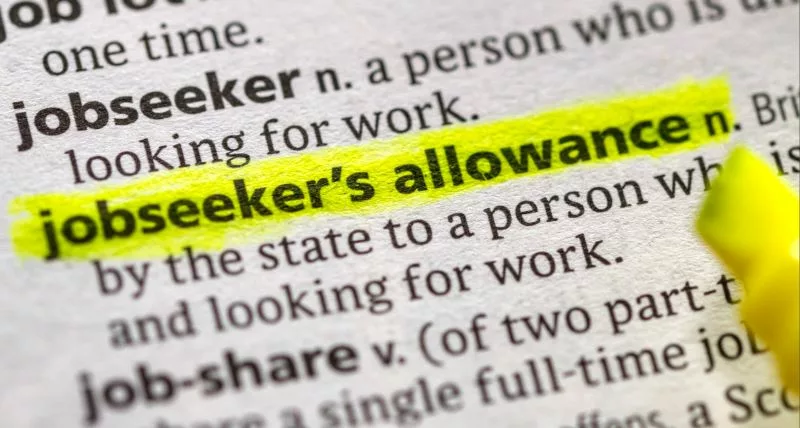If you’re currently facing unemployment, it’s important to know that Job Seeker’s Allowance (JSA) is here to help bridge the gap. This vital benefit offers financial support to those actively searching for new employment opportunities.
Applying for JSA might seem like a daunting task, but it’s straightforward once you know the requirements and steps involved. This guide is designed to give you a clear overview of the process, making sure you’re well-equipped to apply for the financial support you need during this difficult time.

- What Is New Style JSA?
- Who Can Get New Style JSA?
- How To Claim New Style JSA
- How Much Is New Style JSA?
- How Long Can You Get New Style JSA?
- Can JSA Payments Be Reduced or Stopped?
- Stepping Forward with New Style JSA
- FAQ
What Is New Style JSA?
New Style Jobseeker’s Allowance (JSA) is a type of unemployment benefit designed to support those out of work but actively seeking employment in the UK. Unlike other forms of JSA, which could depend on national insurance contributions and income levels, New Style JSA is specifically based on your national insurance contributions in the last two to three years.
While on this benefit, you will receive a small fortnightly payment and assistance from a Jobcentre Plus work coach in finding employment.
What’s the Difference between Jobseeker’s Allowance and New Style JSA?
Jobseeker’s Allowance (JSA), also known as Income-Based Jobseeker’s Allowance, and New Style JSA are both designed to support people in the UK who are out of work and looking for employment. However, they cater to different needs based on your financial situation and work history.
Here is a comparative chart that summarises the main differences between these two programs:
| Jobseeker’s Allowance (JSA) | New Style JSA | |
|---|---|---|
| Eligibility Basis | Income-based, considers the overall financial situation | Based on National Insurance contributions in the last 2-3 years. National Insurance Credits count too. |
| Partner’s Income | Partner’s income affects eligibility and benefit amount. | Partner’s income does not affect eligibility |
| Savings Consideration | Savings over £16,000 can affect eligibility | Savings under £16,000 generally do not affect eligibility |
| Work History Focus | Less emphasis on recent work history | Focuses on recent work history. You must be unemployed or working less than 16 hours a week. |
| Claim Amount | It is not possible to claim JSA anymore. You will continue to receive the agreed payments as long as you remain eligible or until your claim ceases. | Payment is dependent on the applicant’s age. People aged 24 or younger can get up to £67.20. People aged 25 or over can get up to £84.80. |
| Claim Duration | Ongoing support based on circumstances | Up to 26 weeks of support |
| Combining with Other Benefits | Can impact other benefits like Universal Credit | Can be claimed alongside benefits like Universal Credit |
You are no longer able to make new applications for income-based JSA. If you are currently receiving income-based JSA, you will continue to receive payments as long as you remain eligible until your claim ceases.
Who Can Get New Style JSA?
To qualify for the New Style jobseekers allowance, you will need to meet the following conditions:
- Worked in the capacity of an employee
- Paid sufficient National Insurance Class 1 contributions for the previous two to three years (National Insurance credits can also be used)
- Be 18 or above, although some 16 and 17-year-olds are also eligible
- Be under the State Pension age
- Not enrolled in full-time education
- Be ready and able to work (not affected by illness or a disability which prevents you from working)
- Be unemployed or working 16 hours or less
- Live in Scotland, Wales, or England
Those who only paid Class 2 NI contributions and were self-employed are not eligible (unless working as a volunteer development worker or a share fisherman).
How To Claim New Style JSA
Once you checked your eligibility for New Style JSA, you will need to do the following:
1. Start Your Online Application
The easiest way is to apply online. Answer the questions on the online application. You’ll need to provide details about your identity, contact information, National Insurance Number, employment history for the past 6 months, bank account details, and information about your housing costs.
You may also apply with help from the Jobcentre Plus, if you are aged 16 or 17, are applying on someone else’s behalf, are unable to apply online and require assistance, or if you require other forms of communication such as audio CD, braille, or large print.
2. Attend the Jobseeker’s Allowance Interview
Within 14 days of submitting your application, you’ll be asked to attend an interview at your local Jobcentre Plus office. The aim of the appointment is to discuss your circumstances, agree on a plan with your work coach, and set up the steps you will follow to look for work. This includes registering with agencies, writing a good CV, and spending a set number of hours each week seeking work opportunities.
You will also be asked to show:
- One photographic form of identification:
- A valid form of proof of address:
- A utility bill from the previous 6 months (e.g., electric bill, telephone bill, bank statement, etc.)
- The council tax bill from the previous 6 months
- Pension statement or a payslip from the previous 6 months
- Student loan records
- Further proof of identification:
- Cheque book
- P60
- Store or credit card statement
- Savings account book
3. Submit Additional Documents
You may be asked to provide additional documents such as your P45 from your previous employer, bank statements, and proof of identity. Make sure to have these ready.
4. Receive a Decision
After you submit your documents, you’ll receive a decision by post. This letter will inform you whether you are eligible for New Style JSA and the new jsa amount you’ll receive.

How Much Is New Style JSA?
After the interview, the DWP will notify you of the interview’s outcome in writing. The letter will state whether you qualify for Job Seeker’s Allowance and the amount you will receive. The exact amount will depend on individual circumstances (e.g., the payments might be less if working part-time, holding savings, or a pension). However, in general, you can expect to receive the following:
| Payment Amounts | New Style JSA |
|---|---|
| Age 18 to 24 | £67.20 per week |
| Age 25 or over | £84.80 per week |
If after 6 months no employment opportunities are found, people are often moved to Universal Credit.
How Long Can You Get New Style JSA?
This benefit is paid to jsa job seekers for 182 days (approximately 6 months). It is possible to backdate payments by as much as 3 months.
Can JSA Payments Be Reduced or Stopped?
To keep receiving new style jobseekers allowance, you must attend your meeting with your work coach every 2 weeks to discuss how you have been getting on with your job search process. You may be asked to show applications for potential jobs and get asked questions about the interviews attended.
If the obligations are not met, the JSA might get stopped or reduced. This is referred to as a “sanction.” Potential reasons why a person may become “sanctioned” include the following:
- Not attending agreed interviews with the work coach
- Not keeping up with the agreed commitments
- Not accepting training opportunities or job offers
- Not applying for positions indicated by the work coach
- Not attending any booked training courses or other employment schemes
Other reasons for sanction include:
- Not starting work immediately after finding a job
- Taking a pay cut in the current job without a valid reason
- Be subjected to a pay cut because of something the candidate did at their job (for example, behaviour)
- Leaving a job or training course without a valid reason
While on a new JSA, reasonable action must be taken to find employment.
Change of Circumstances
All changes in circumstances must be reported to the Job Seekers Allowance Office. You can notify them through your online account or by calling them on 0800 1690310. Examples of a change of circumstances include:
- Stopping or starting training or educational programs, apprenticeship schemes, or work
- Changes to the partner’s income or working hours
- Moving homes
- Changing names
- People moving in or out of the house (for example, a partner or child)
- Changes to other benefits received within the home
- Changes in pension, savings, property, or other types of investments
- Any additional money received
- Changes to a disability or medical condition
- Moving into sheltered accommodation, a care home, or entering a hospital for a prolonged period
- Going overseas
- Immigration status changes (for those who are not British citizens)
It is important to provide accurate information, or you may be liable to a £50 fine or prosecution in severe cases or with fraudulent attempts.
Stepping Forward with New Style JSA
New Style Jobseekers Allowance offers essential financial assistance and guidance for individuals who find themselves unemployed and in the process of job hunting. Beyond the fortnightly “personal allowance” designed to alleviate financial pressures during this transitional period, the program also includes personalized support from a work coach. This dual approach not only aids in covering immediate expenses but also strategically assists in navigating the job market, significantly enhancing the chances of re-entering the workforce successfully.
FAQ
How Long Does It Take To Get the New Style JSA?
If your claim is successful, you’ll receive New Style JSA payments every two weeks.
Can I Claim Job Seekers Allowance If I Have Savings?
Yes, you can claim New Style Jobseeker’s Allowance (JSA) regardless of your savings. New Style JSA is based on your National Insurance contributions, not your income or savings.
Can You Claim Jobseekers Allowance and Universal Credit?
Yes, you can claim New Style Jobseeker’s Allowance and Universal Credit together. Your New Style JSA payment will be considered income when calculating your Universal Credit amount.
What If You Are Refused New Style JSA?
If you are refused New Style Jobseeker’s Allowance (JSA), you can challenge the decision by asking for a mandatory reconsideration within one month of the decision. If you’re still unhappy with the outcome, you can then appeal to an independent tribunal. Additionally, you might be eligible for Universal Credit or other benefits, depending on your circumstances.





